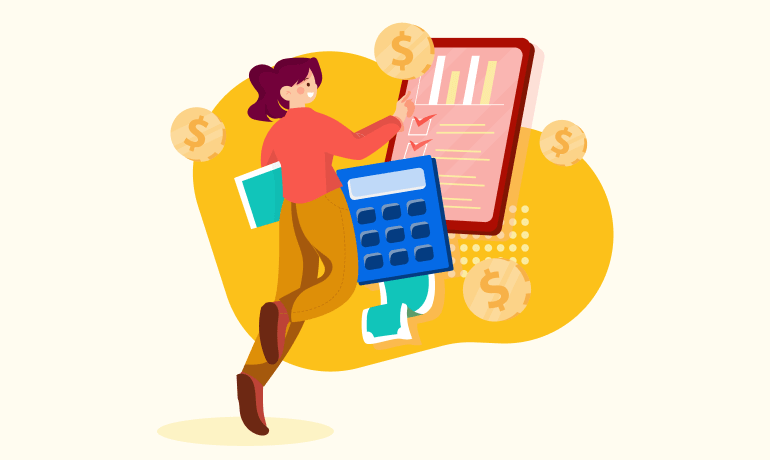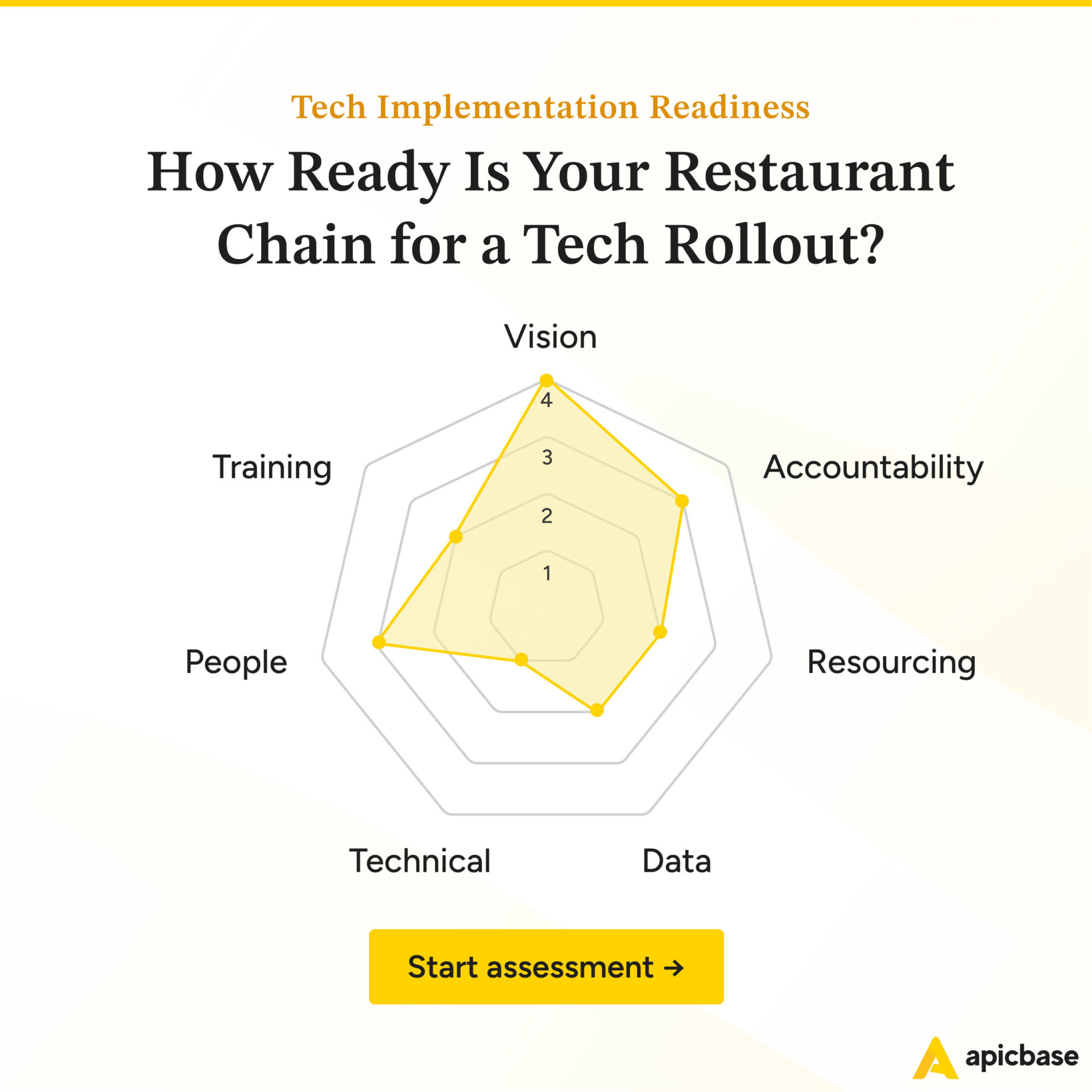For restaurant operators and F&B operations managers, the devil really is in the details. It’s an ironclad rule in the hospitality industry and menu costing is no exception.
The most important of those details is your cost baseline. It’s essential for everything you do, from menu pricing to closing the gap between theoretical and actual food costs i.e. detecting the causes of food cost variance. And to get to it, you need accurate menu costings.
This is where things get a bit complicated, right?
And that’s because…
Menu costings go out of date as soon as you launch a menu!
So you either spend your life with a calculator in hand… or you give it the good, old shrug of resignation and accept that your cost baseline is a close guess, at best… or a mile off, at worst.
But what if I told you there’s a third option?
A way to automate F&B costing so that you have real-time access to your cost baseline… without guessing and without crunching the numbers?
There is… and you’ll know all about it after reading this post.
Here’s what we’ll be discussing:
- what is menu [recipe] costing [and why it’s too essential for you to ignore]
- why the traditional way of costing out an F&B menu is broken
- how Apicbase fixes menu costing and saves your time, money & growth
- 3 ways in which always-on menu costing maximises your profits
- why Apicbase is your ticket to real-time cost baseline
First, let’s sink our teeth in the menu costing definition.
What’s Menu [Recipe] Costing [& Why You Need It Done Right]?
What is menu costing?
Menu costing is the process of finding out what each menu — [or recipe, in which case it’s called recipe costing] — costs you in preparation.
It’s a theoretical number — how much do your menu and recipes cost in an ideal world where everything is done right, and there are no variations in costs or waste. As such, it provides a baseline against which you benchmark your real-world data.
Keeping track of menu costings and ensuring they’re always up-to-date allows you to measure and improve profitability and reign in operational expenses.
You might have noticed that the definition calls menu costing a theoretical number.
But… this doesn’t mean that it’s a number you pull out of the hat. It’s based on painstaking calculations of your ingredient prices and production costs.
Even a small deviation [such as a change in the price of one ingredient] will throw this calculation out of whack.
That’s why restaurant menu costings should be consistently revised and updated. Otherwise, you’re simply not agile enough — nor do you have the data — to make the necessary changes fast enough to avoid the hidden expense of not knowing how much something is costing you.
And it’s precisely this necessity to continually check and recheck menu costings that makes the traditional approach to it so broken and useless.
The Traditional Approach to F&B Costing is Wrong. Here’s Why:
How most foodservice operators approach menu costing right now is unnecessarily long and laborious.
From putting together the initial recipe to consulting vendor pricing lists, it takes several hours to get everything set up the way you want it.
Another challenge is how you’re doing it — spreadsheets are difficult to update, especially if you’re sharing them across different outlets.
Three things are wrong with this approach:
- the initial recipe costing takes too much time — it’s a manual process with no guarantees of getting the best possible result. You can spend hours costing a single recipe and still end up with an underperforming item because you’ve unknowingly selected a more expensive vendor.
- it’s impossible to catch a significant change as soon as it happens — unless you’re looking at every vendor invoice/price list as it rolls in, you can’t see every price/packaging change. By the time you do see it, the damage has been done.
- when something changes, fixing everything takes too much time — your costed recipe links to raw ingredient + labour costs on one side, and it informs your pricing and menu engineering on the other side. A single raw ingredient change means you have to consult a bunch of vendor-side papers… and then tweak every costed recipe that uses that ingredient.
[COB] Get #1 Back of House Software: Manage Recipes, Purchasing, Inventory and Analytics All in One Place. Apicbase gives your teams the tools and data to reduce food costs and drive operational excellence across your restaurants.
Menu Costing in Apicbase is Easy, Accurate & Always-On
The process I describe above takes hours sometimes — days even when you’re just setting things up.
Doing it the Apicbase way frees up your time and makes everything more accurate. The costing process is automated through the product development module — recipe costs and menu margins get updated across your entire operation, no matter how many outlets you run. This way, all your managers are looking at the actual numbers instead of basing their decisions on back-of-napkin estimates that may or may not be correct.
Let me demonstrate.
This is your recipe in Apicbase:
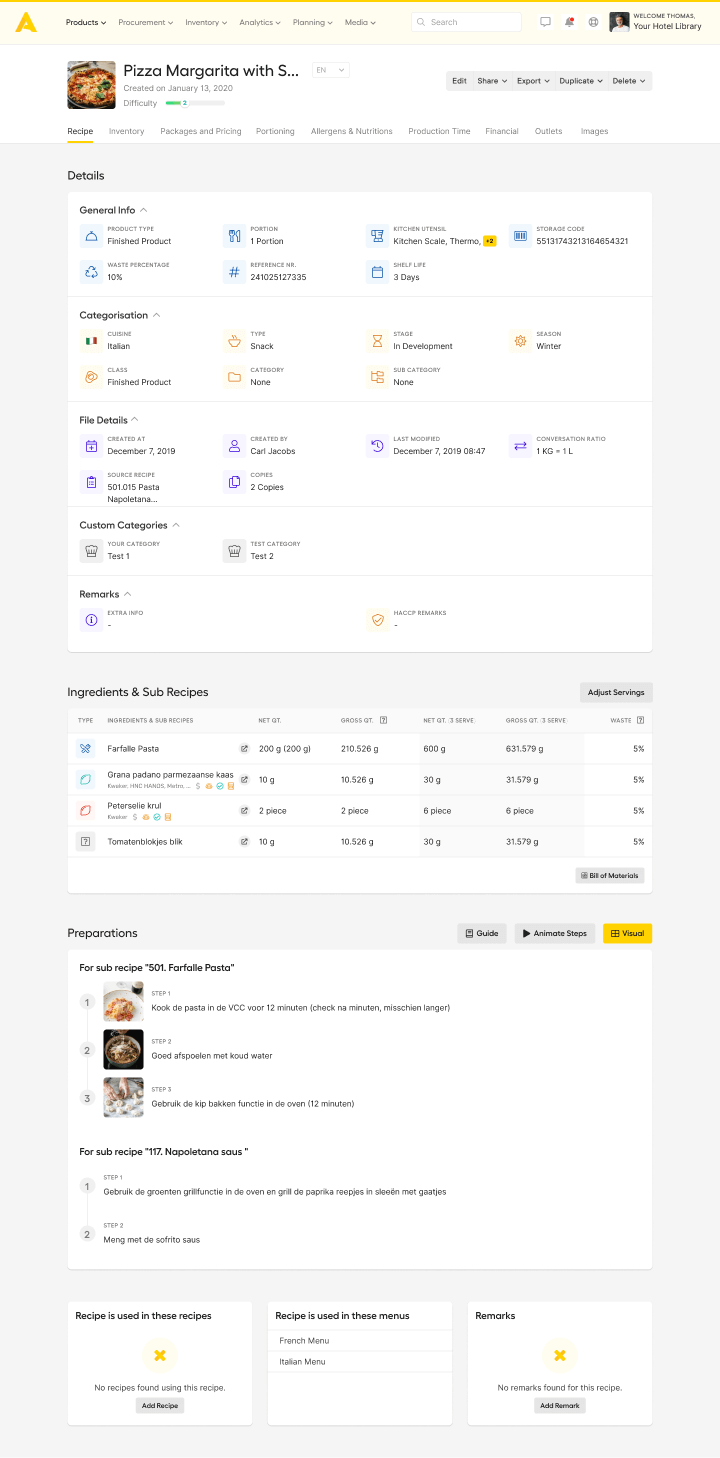
Streamlined, easy to access, and loaded with the info your BoH staff needs for prep and everything your FoH staff needs to make the sale and answer customer questions.
STEP #1
I’ll first tackle the ingredient and sub-recipes section for clarity. This is your inventory from which all your recipes are created.
It can take some time to set this up, but once it’s done, you’ll only do minimal tweaks to it; for example, whenever you add a new ingredient/sub recipe or there’s a change in price/packaging.
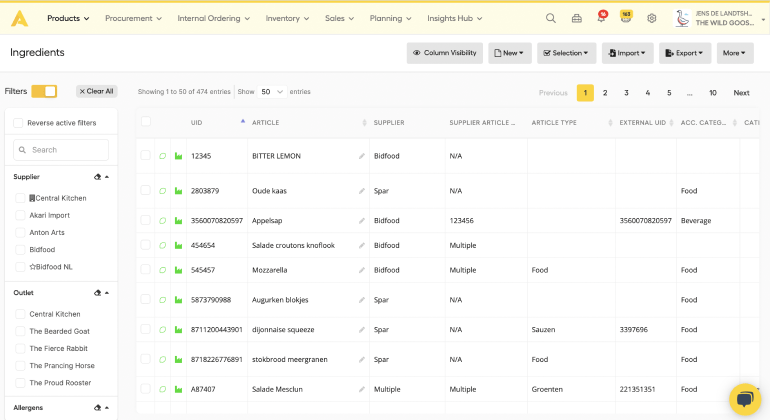
NOTE: You can do this manually but also import individual XLS files from your vendors. This is especially useful if you work with a lot of vendors and need to add hundreds of raw ingredients.
Learn more: Restaurant Inventory Management Software
STEP #2
It takes a few minutes to populate a new recipe in Apicbase. Once you fill out a few basic fields [recipe name, product type, shelf life, and prep difficulty], all you need to do is add the ingredients from a dropdown menu and enter the quantities.

NOTE: You can [and should] go real granular here, adding prep steps, production notes, images, and allergen/dietary info data to all your recipes.
STEP #3
You’re done.
Once you create a recipe in Apicbase, it’s already costed. You don’t have to go back and do the math manually. The system pulls all the data from your inventory, calculating the recipe/menu costs and even the portion cost.
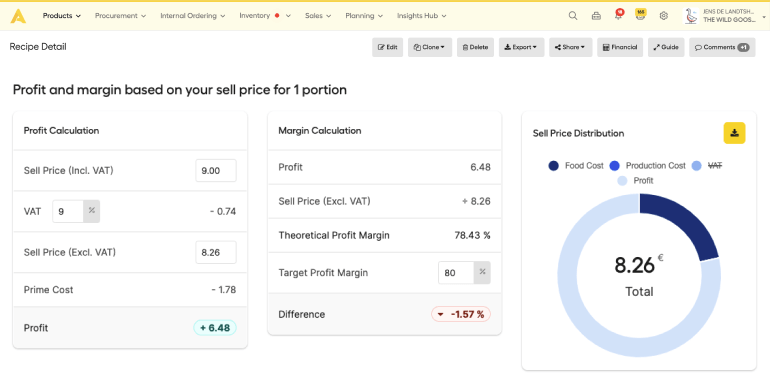
STEP #4
Food cost percentage and profit margin setup. This step goes beyond menu costing, but it’s at the core of what makes Apicbase valuable to restaurant business owners. Once you set this up, you can track — instantaneously — how each of your dishes and menus is performing. If something goes wrong, you’ll instantly know about it, so you can take corrective measures that will save your bottom line.
Additionally, you can add labour costs to the mix, so you end up with the prime cost for each recipe.
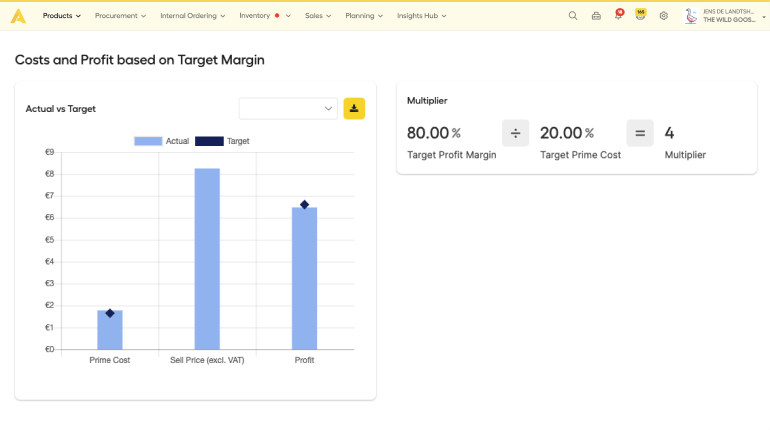
When you connect your vendors to the platform, Apicbase will automatically take all vendor-initiated changes [pricing and quantities] and apply them to your recipes.
This means that everything is costed in real-time. And even if you can’t do that [because not all vendors are able or willing], it’s easy enough to update your ingredients frequently to get a similar level of control.
Congrats — you just saved 15 hours per month, AND you have a tool to make meaningful tweaks that will result in lower food costs.
3 Reasons for Keeping Your Menu-Costing Up-to-Date
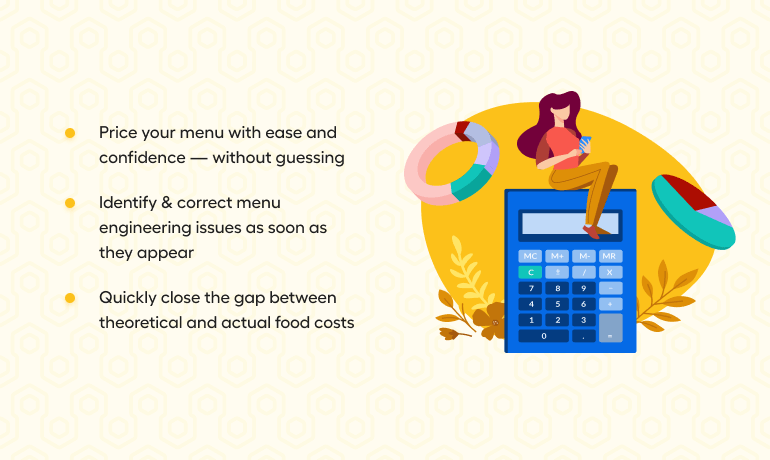
Almost everything you do as an F&B operator or a restaurant operations manager is in service of one thing, and one thing only — maximizing guest experience.
But… a close second place goes to turning a healthy profit. You’re running a business, after all.
This means digging into the cost side of the equation to:
- find glaring holes that need to be plugged and;
- keep tabs on small wrinkles you want to iron out.
It’s the wrinkles that are usually the problem for an F&B operator. To keep on top of those wrinkles [because they add up], nothing’s more important than how you handle menu costing.
Accurate menu costing is a baseline requirement if you want to:
- price your menu with ease and confidence [and without guessing]
- identify & correct menu engineering issues as soon as they appear
- quickly close the gap between theoretical and actual food costs
Let’s take a closer look at these three processes, as well as how Apicbase makes it easier to handle them without things falling through the cracks.
Data-Driven Menu Pricing Updates [& No Expensive Guestimates]
What happens when you do your menu costing once and then forget about it?
Well, for starters, you’re oblivious to tiny increases in costs of goods sold [CoGS]. Every time you sell a menu item that’s not accurately costed, you take a percentage profit hit.
The bigger issue, of course, is when those costs explode — and you’re still oblivious to them.
For example — a friend who ran a small street food chain in Brussels, Belgium. His staple dish was a herb-infused salmon burger. It was wildly popular, but he costed it once, and then he let it sit. When the salmon vendor changed the packaging and prices, my friend’s margin disappeared. In the month that took him to notice this, his business was already struggling.
With Apicbase, this would have never happened to him.
The reason is simple — Apicbase tracks cost-side changes at all times. You set this up once on the recipe level, and that’s it. All that’s left for you is to periodically check the reports. If your food cost is going up, you’ll immediately see it… and you can take steps to correct it.

And in the case of things really going belly up, our Apicbase Assistant will notify you:
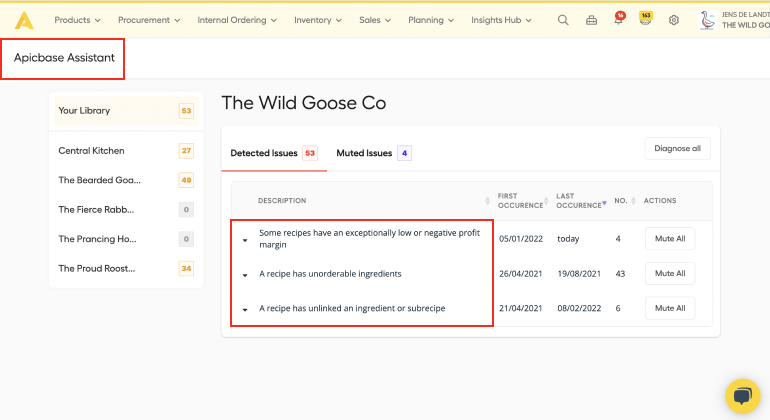
This ensures you’re kept in the loop even when not actively checking everything.
Keep track of food cost and optimize your bottom line with first-class Food Costing Software
Profit-Maximizing Menu Engineering [You Can Tweak On the Fly]
Staying on top of your menu engineering lets you gauge the performance of your menu items [profitability vs. popularity]… reassess your pricing decisions… and work on boosting your profit margins and total revenue.
But… it’s still a whole lot of math.
For example — let’s say you have a plowhorse menu combo [steak burger, twice-baked potatoes & garlic butter mushrooms]. It’s very popular, but just profitable enough [thanks to the high food cost items it uses] to stay on the menu. Once you identify it, you decide to add a profit-boosting beverage to it, a Bloody Mary, for example.
But how does this go?
Do you recheck the margins regularly to see if you’re making more money? Do you recalculate things whenever there’s a change? Because that’s what you should be doing. And you should be doing this every time you tweak your menu… and every time there’s a cost-side change.
If you don’t stay on top of it, you’re back on square one.
Let’s get back to that menu combo. What happens when an ingredient price hike pushes your profit-boosting Bloody Mary down to a break-even point? Or the price of your mushrooms goes up? Well, then this menu goes back to being a plowhorse — and it’s not turning a healthy profit for you.
But what if you could see this in real-time, like this:
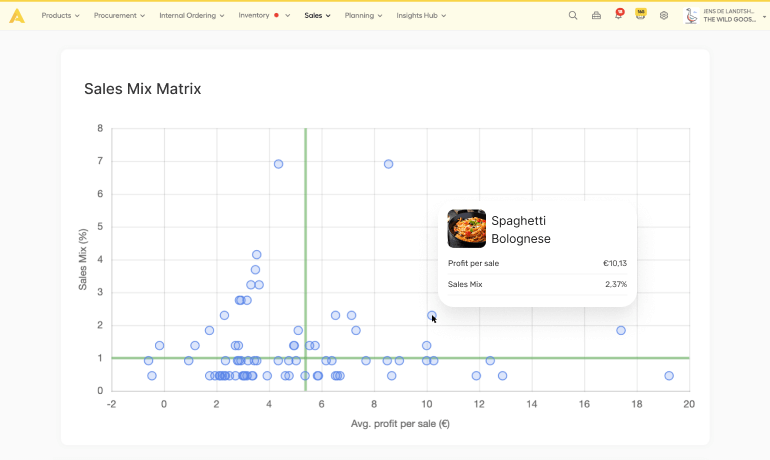
This is Apicbase’s Profitability Matrix, which is part of the sales analytics module. It shows, at a glance, which menus or items fall into which category — what’s a star, an opportunity, a puzzle, or a dog. No math is needed — you just fire up the report, and you get access to actionable data you can now use to stop profit from bleeding out of your operation.
You can also use the Profitability Matrix to double down on those menu items that show promise. These are low food cost items that are not getting a lot of traction with the customers. The problem might be in menu prices, menu design, or something else. When you know about them, you can try different marketing tactics, and hopefully, increase your total sales and revenue.
The granularity of these reports — and consequently, of your decision-making — is only possible because Apicbase makes it easy for you to stay on top of menu costing.
Learn more about the Apicbase Menu Engineering module
Bridging the Gap Between Theoretical & Actual Food Costs
Know that stomach-churning feeling you get when you stare down the barrel of a P&L statement, and you immediately realise that things do not add up?
There’s variance there that you’ll need to hunt down, and that’s going to take you days… if you can even unearth it.
And unearthing that food cost variance is back-breaking work.
Digging through statements… poring through inventory records… double-checking vendor pricing — all this takes time. And the longer the variance manages to elude you, the more substantial the hit to your bottom line.
Apicbase fixes this clunky process.
Thanks to the platform’s always-on F&B menu costing, you won’t be going in blind when bridging the gap between theoretical and actual food costs.
And you won’t even have to rely on your P&L statements to tip you off about a problem.
This will solve two of your biggest problems:
- often acting months after the event that has caused the variance [since a P&L statement is often made quarterly, and rarely monthly], which makes data reconciliation almost impossible… and the damage that’s been done can’t be undone, and;
- wasting hours — and sometimes even days — to pinpoint the cause when you do manage to find it… days that you could spend focused on other business-building activities.
With Apicbase, you’re seeing the food cost variance unfolding in real-time [and, as I mentioned, it’s not necessary to keep checking on it all the time — the Apicbase Assistant notifies you when things get seriously out of hand].
However, if you want to stay on top of things at all times, Apicbase makes that really easy:
First, you check the ‘Financial’ tab of the recipe. This is where your prime cost is calculated and a theoretical profit margin is set:

After that, you take a stroll through the ‘Sales Analytics’ module and locate the same menu item:
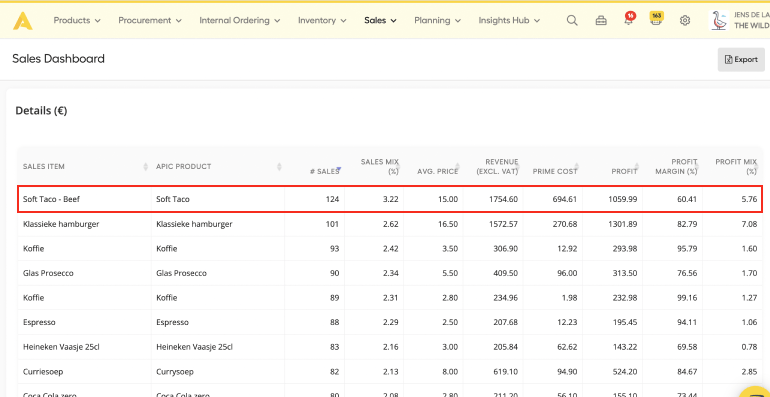
In this example, we can see that there’s a big difference between the theoretical profit margin [set at 75%] and the actual profit margin of the dish [which clocks in at about 60%].
Now you can evaluate and decide what needs to change… and does this item even earn its keep on the menu.
Raw ingredient price increases that eat into your profit margin will be immediately visible, so you don’t have to hunt them down. Once you notice them, you have two options — find a more affordable vendor or adjust the price, so you end up back on your target food cost.
But if your food cost control is tight — if your plate cost is not going up — but you’re still seeing variance in your P&L statements, you now know to look elsewhere. Your first steps should be to check for increased food waste, a clunky production process, and incorrect plating. Whatever it is that ends up being responsible for messing up your mark-up margin, you can now get to it — and fix — faster than ever before.
Learn more: Apicbase Sales Analytics module
Apicbase — Your Spreadsheet-Free, Always-On Recipe Costing Software
Right now, the cost of running a restaurant is soaring (actually, it’s soaring most of the time).
Rising food prices and supply chain issues make it nearly impossible for many operators to stay afloat. And not having a tight grip on your menu costing only worsens the problem.
But this is a problem you don’t need to have.
You can offset it by always having access to your real-time food costs and contribution margins. That way, you can make the necessary tweaks whenever your bottom line gets affected.
That’s what Apicbase brings to the table.
The ability to set a correct real-time baseline so that all your upstream activities take a fraction of the time to do. Adjusting menu prices based on new, increased costs of raw ingredients… tweaking your menus when they dip below desired profitability… and staunching the flow of revenue the minute you see that ugly food cost variance rearing its head.
Do that — and more — with Apicbase.

See Apicbase Menu Costing Software In Action
👆 (Click on the link to fill out the demo form. Let’s arrange a date and time that works for you.)

